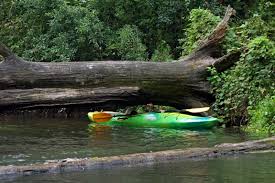Obstacles on the canoe trail

Knowledge of the terms mentioned, regarding the waterway, as well as signs and signals, it can save us from all kinds of obstacles and surprises, what await us on the trail.
If we go along the marked trail, watching the signs carefully, this percentage of danger is, of course, much lower.
Most, however, canoeists engage in this type of tourism for this reason, that he can kayak not only on famous people, popular routes, but on the smallest rivers, where no one will disturb the peace, where every stroke of the oar is, every movement of the kayak discovers new ones, hitherto unknown views. An experienced canoeist can reconcile the perception of these impressions with careful observation of the trail and the water surface, so as not to be surprised by the sudden stranding of the kayak, a big boulder or a sharp beam of an old bridge. A fallen tree can be just as dangerous, obstructing the entire width of the bed or sudden acceleration in front of the weir and the need to overcome the culvert.
Passing under the footbridges requires a lot of attention and proper assessment of the situation, bridges and bridges. If there are rafts on the trail, we must be carefull, lest we be pressed to the shore. Suppose, that the prow of the canoe ran aground in a strong current. A strong current will turn the canoe stern forward. Depending on the type of sandbar, our reaction will be different. If the prow of the canoe is wedged between the rocks, we must not allow it to be reversed, because it may damage the kayak. We need to get out quickly (while paying attention to the safe positioning of the legs), push the canoe down and swim into deep water.
If the bow of the canoe ran into a sand bar, soft, then we can allow the kayak to be turned over, accelerating this maneuver by counteracting and earning. In this way, the current will pull us off the shoal. After entering deeper water, we make one more turn and we are directed in the right direction.
It is best to swim in the middle of the current, which is not easy and for beginner canoeists a bit of trouble. The least pleasant for canoeists are the obstacles, when overcoming which we have to resort to "carrying.
So overcoming the obstacle in our way (fallen trees, tama, closed culvert, a trellis blocking the way of the fish, a very low bridge or footbridge) by carrying the kayak along the shore around it. When starting to do so, we must bear in mind a few rules:
1. We hit the shore in the right place, i.e.. for that, where we will be able to unload the kayak and pull it out of the water. The closer we get to the obstacle, this way we will have a shorter land route. However, it will not always pay off, because near some obstacles the speed of the current increases sharply, which makes it more difficult to beat and other activities.
2. We always finish off with the kayak's bow pointing upstream. You should tap softly, and when the water becomes shallow, one should enter it, bring the canoe and moor it. Be careful when entering the water, not to step on glass or other sharp objects.
3. Kayak (both stiff, as well as the folder) must be unloaded. We just can't advise Sztywniak trying to get him out of the water, because the weight of the kayak and luggage is strongly sucked by the water.
A loaded folder may break when you try to pull it out of the water.
A. We take the canoe out of the water by a strong grip on the stern and bow, and at the same time vigorously pull it out of the water, up. You can also carry it, resting on your shoulders or hips. Any dragging of the kayak on the ground, placing round stakes and pulling on the "burlap" is not allowed, because it destroys the canoe. It goes without saying, that the owners of the stroller use it for this kind of "portages."”.
5. After moving, launch the canoe behind the obstacle (bow against the tide), we moor with bow and stern mooring, we carry the luggage, we pack and set off.
In the open, wide waters, wind and waves create a lot of difficulties for a canoeist. When going against the wind, to reduce drag, Place the oar blades at right angles, in crosswind, after ballasting the bow, we always steer to the wind. We cross the wave by steering the canoe perpendicular to it.
Ships, fast motorboats always pose a great danger for a canoeist. Avoid getting too close to them. After crossing them, place the canoe perpendicular to the generated wave.
And on the rivers, and on lakes, in all dangerous cases, try to stay cool, sober assessment of the situation and quick, correct reaction.